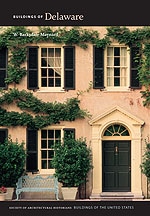
This new development, one of many around Middletown, differentiates itself by including diverse housing types, ranging from estates to small homes. The developer's promotional literature calls it Delaware's first example of “Traditional Neighborhood Development,” or New Urbanism. Consisting of 492 houses on 300 acres, it seeks to turn back the clock to before the time when “the post–World War II era gave birth to Levittown. Parkside will be a place where sidewalks and pedestrian traffic trump highways and automobiles. Where community parks and a community club house foster neighborhood gatherings. Where front porches replace rear decks.” Philosophically similar developments are Kentlands in Gaithersburg, Maryland, and Eagleview in Downingtown, Pennsylvania, although the styles of the houses differ there. The “two-story, neo-traditional homes reflecting a mid-Atlantic or Southern heritage” have garages at the rear only, on alleys. Three home-building companies have contributed. Narrow, tree-lined streets with “traffic circles, pocket parks and a variety of traffic-calming devices” are designed to slow automobiles. An eight-acre park is at the center of the town, with a community center. Parkside is the latest innovation among many in the long history of tract-house suburbanization in Delaware.

